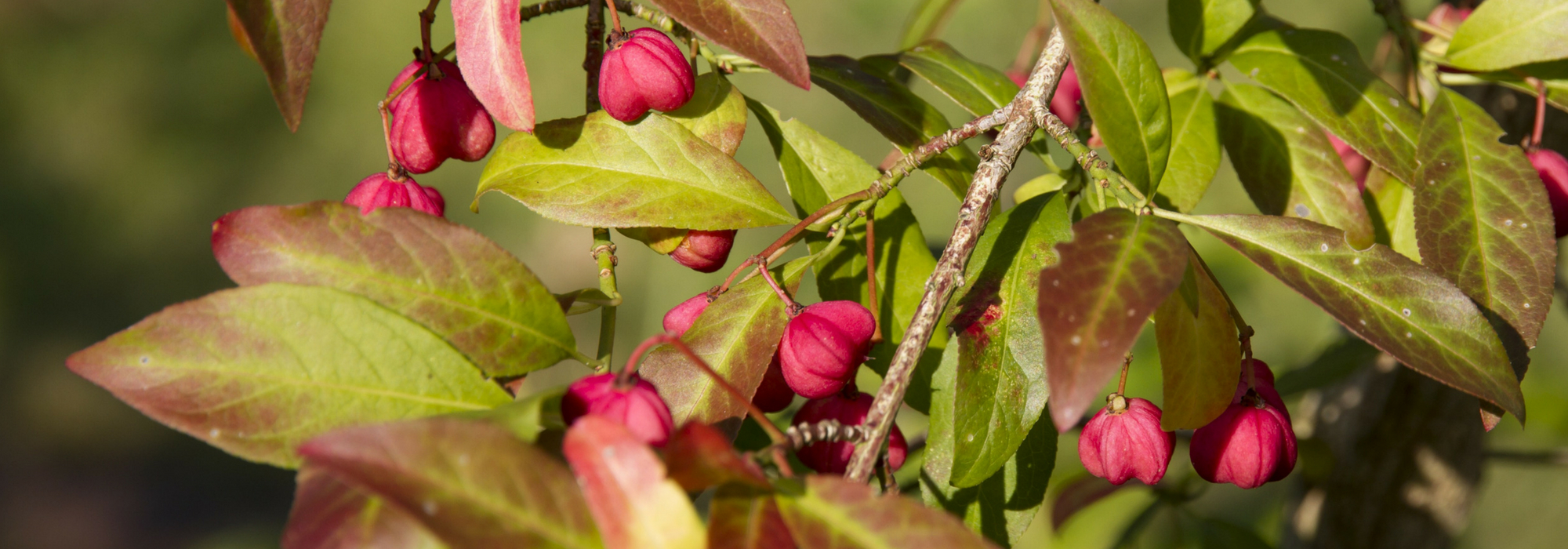
Euonymus: planting, pruning, and maintenance
Contents
The Spindle, in a nutshell
- Euonymus are bushy ground cover or large shrubs that offer a multitude of habits and colours
- The evergreen or deciduous foliage presents interesting shapes, variegated with cream, yellow, or even pink, as well as stunning autumn colours in the deciduous varieties
- The fruits provide original decorative interest in certain species, and birds enjoy them in autumn
- Hardy, they adapt to all well-drained soils and tolerate shaded or sunny exposures
- Their uses are varied, ranging from rockeries to hedges, including trimmed borders, topiaries, or small shade trees
- This is the foolproof bush that every beginner gardener will plant in their garden
A word from our expert
Spindle trees form a family of bushes that are very varied, sometimes deciduous, sometimes evergreen, making them suitable for multiple uses. They are all very easy to establish in well-drained soil and are low-maintenance once they are established.
Discover this wide range of attractive bushes, both for their shape and the colour of their foliage. Evergreen species are appreciated for their variegated foliage, sometimes very fine, ideal for bonsai cultivation. Deciduous species are particularly appealing for their autumn foliage and colourful fruits.

Some spindle trees with decorative evergreen foliage: Euonymus fortunei ‘Emerald ‘n Gold’, Euonymus japonicus ‘Pierrolino’, Euonymus japonicus ‘Bravo’, Euonymus fortunei ‘Minimus’, Euonymus fortunei ‘Emerald Gaiety’.
Spindle trees prefer sunny or partially shaded situations and well-drained, rather cool soils. Deciduous species can even tolerate poor soils, regardless of pH. Compact and dwarf bushes are suitable for container planting, while vigorous specimens integrate perfectly into hedges, borders, and even make beautiful standalone subjects. Some cultivars aim to replace traditional boxwood borders that have been decimated today. Pruning of deciduous spindle trees is done in winter, while that of evergreen spindle trees intended for borders, hedges, or topiary is carried out in April and autumn.
Description and Botany
Botanical data
- Latin name Euonymus sp.
- Family Celastraceae
- Common name Spindle
- Flowering depending on the varieties, between May and August
- Height between 40 cm and 5 m
- Sun exposure Full sun to partial shade
- Soil type fairly cool and drained, rich or poor depending on the species
- Hardiness Very good most of the time
Le genre Euonymus, parfois orthographié Evonymus, est plus connu sous le nom de spindle. Il regroupe plus de 175 espèces d’arbres, d’arbustes et de plantes radicantes (qui s’étalent en produisant des drageons) voire rampantes. La plupart poussent dans l’hémisphère nord, les plus remarquables (Euonymus japonicus, alatus…) se situant depuis l’Himalaya jusqu’à l’Extrême-Orient en passant par l’Asie du Sud-Est. On en trouve aussi en Amérique du Nord (4), en Australasie et Madagascar. Mais nous possédons notre propre espèce européenne le fusain d’Europe, Euonymus europeus, largement répandu depuis la Finlande jusqu’à l’ouest de l’Asie mineure, surnommée le « bonnet d’évêque » en raison de la forme des fruits.
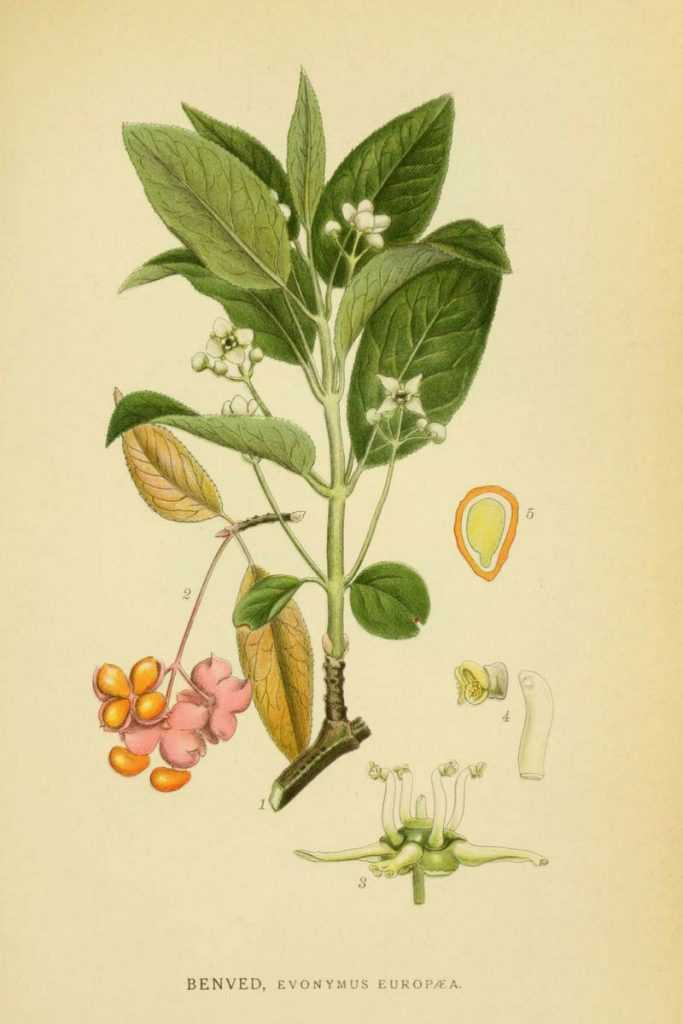
Euonymus europaeus, botanical illustration
Le genre Euonymus, appartenant à la famille des Célastracées, se caractérise par des feuilles simples de 5 à 12 cm de long, opposées mais parfois alternes et généralement à bords dentés munis d’un court pétiole. Parmi les membres de cette famille figure le Celastrus, un arbuste grimpant décoratif par ses fruits orange. La forme du limbe est assez classique, ovale à lancéolée, parfois acuminée. Les fusains se divisent en deux familles dont l’usage diffère, les espèces persistantes et caduques.
Les fusains à feuilles persistantes (Euonymus japonicus, fortunei…) présentent une texture coriace, cireuse et un feuillage dense, souvent coloré, apprécié pour former des haies, garnir une rocaille ou servir de point d’appel en isolé.
Les espèces caduques (Euonymus alatus, europaeus, bungeanus), à feuilles ordinaires, se rattrapent à l’automne en offrant de superbes couleurs de feuillage pourpre, écarlate à orange mêlées à celles des fruits.
Les rameaux bruns ou vert sont lisses ou quadrangulaires. Parfois, des excroissances liégeuses garnissent les tiges donnant un aspect ailé comme l’écorce de l’Euonymus alatus ou E. phellomanus.
Les fleurs, formées de 4 pétales sont groupées en cymes, au départ des pousses de l’année et sont assez insignifiantes en raison de leur taille réduite, de leur teinte verdâtre ou jaunâtre, parfois rose et de la quasi absence de parfum. La floraison a lieu entre mai et août selon l’espèce, une fois que la feuillaison est achevée.
Les fruits sont en revanche remarquables lorsque la capsule rose indien ou rouge, qui s’ouvre habituellement en 4 valves laisse apparaître les 3-4 graines colorées d’orange vif, de rouge vermillon ou de rouge corail. Ces graines portent une enveloppe charnue, oléagineuse, très nutritive pour les oiseaux, appelée « arille » qui permet la dissémination de la semence dans leurs déjections. Elles restent accrochées un certain temps à la capsule.

The berries of some species of spindle are very decorative: Euonymus planipes, Euonymus europaeus, Euonymus phellomanus, Euonymus europaeus.
Les fusains asiatiques suscitent déjà l’intérêt du jeune naturaliste Victor Jacquemont (1801-1832), missionné par le Museum de Paris pour un premier voyage au Cachemire et au Penjab en 1830. Eunonymus japonicus devient populaire en Europe au 19e siècle. Il fournit un bois dur et robuste pour la fabrication de fuseaux à filer la laine mais il est surtout connu par les artistes dessinateurs pour son bois transformé en charbon qui permet d’esquisser des croquis sans marquer la feuille (d’où le nom de fusain). Ses racines produisent un latex de type « gutta percha » que l’on extrait aussi d’autres arbres de la famille des Sapotacées notamment.
The main species and varieties
The spindle trees offer a range of astonishing habits. Euonymus fortunei, the best known and undoubtedly the most popular of all, is capable of spreading up to 6 m long and even climbing trees like ivy, aided by its climbing roots. However, its cultivars are usually more compact and rarely exceed 1 m in spread. These are well-suited for pot cultivation or for creating topiaries, even though their growth is somewhat faster than that of boxwood.
The Japanese spindle tree (Euonymus japonicus) forms a small evergreen tree with a spreading habit of 3 to 5 m high, although its variegated cultivars rarely exceed 1.50 m in all directions. Its deciduous counterpart, the European spindle tree (Euonymus europaeus), also provides ideal shade in a small garden, with a spreading habit of 3 to 5 m in height.
To find out which variety will best suit your garden, check out this article: “Spindle tree: which variety to choose?
The most popular varieties
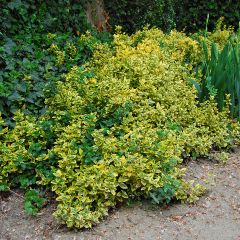
Euonymus japonicus Aureus - Japanese Spindle
- Flowering time June to August
- Height at maturity 1,50 m
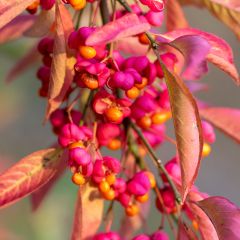
Euonymus europaeus Red Cascade - European Spindle
- Flowering time May
- Height at maturity 3 m
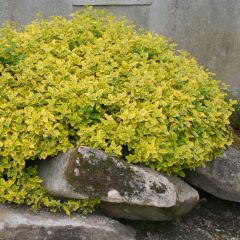
Euonymus fortunei Emerald n gold - Spindle
- Flowering time June, July
- Height at maturity 60 cm
Our favourite varieties
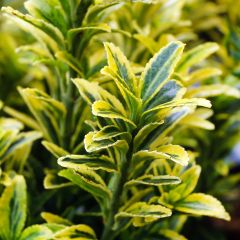
Euonymus japonicus Microphyllus Aureovariegatus - Japanese Spindle
- Flowering time June to August
- Height at maturity 1,20 m
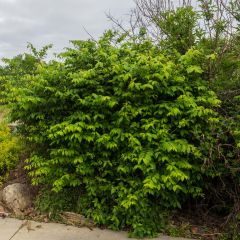
Euonymus alatus Compactus - Winged Spindle
- Flowering time June, July
- Height at maturity 1 m
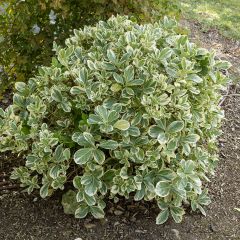
Euonymus japonicus Bravo - Japanese Spindle
- Flowering time June to August
- Height at maturity 2 m
Discover other Euonymus - Spindle tree
View all →Available in 3 sizes
Available in 3 sizes
Available in 4 sizes
Available in 2 sizes
Available in 2 sizes
Available in 2 sizes
Available in 1 sizes
Available in 2 sizes
Available in 2 sizes
Available in 2 sizes
Planting Euonymus
Where to plant?
Plant your spindle tree in a sheltered and sunny location. However, the variegated forms will look nicer in partial shade and will additionally provide a lovely creamy or golden luminous touch. The forms with entirely green leaves tolerate more shade than the variegated ones.
Deciduous spindle trees (europaeus, alatus, grandiflorus…) are very hardy and can be planted throughout France, except in dry Mediterranean climates.
Among the evergreen forms, fortunei spindle trees can withstand severe cold down to -28°C. In contrast, japonicus spindle trees are more delicate; avoid exposing them to temperatures below -12°C (zone 8 maximum), but they tolerate salt spray perfectly.
Evergreen spindle trees thrive in neutral to calcareous soil, which is rather rich and cool, while deciduous spindle trees, indifferent to pH, are content with poor, well-drained soil that is relatively cool in summer. In all cases, avoid waterlogged soils, even though spindle trees appreciate some moisture around their roots. Add a layer of gravel at the bottom of the planting hole if necessary, or plant on a slope to promote drainage.
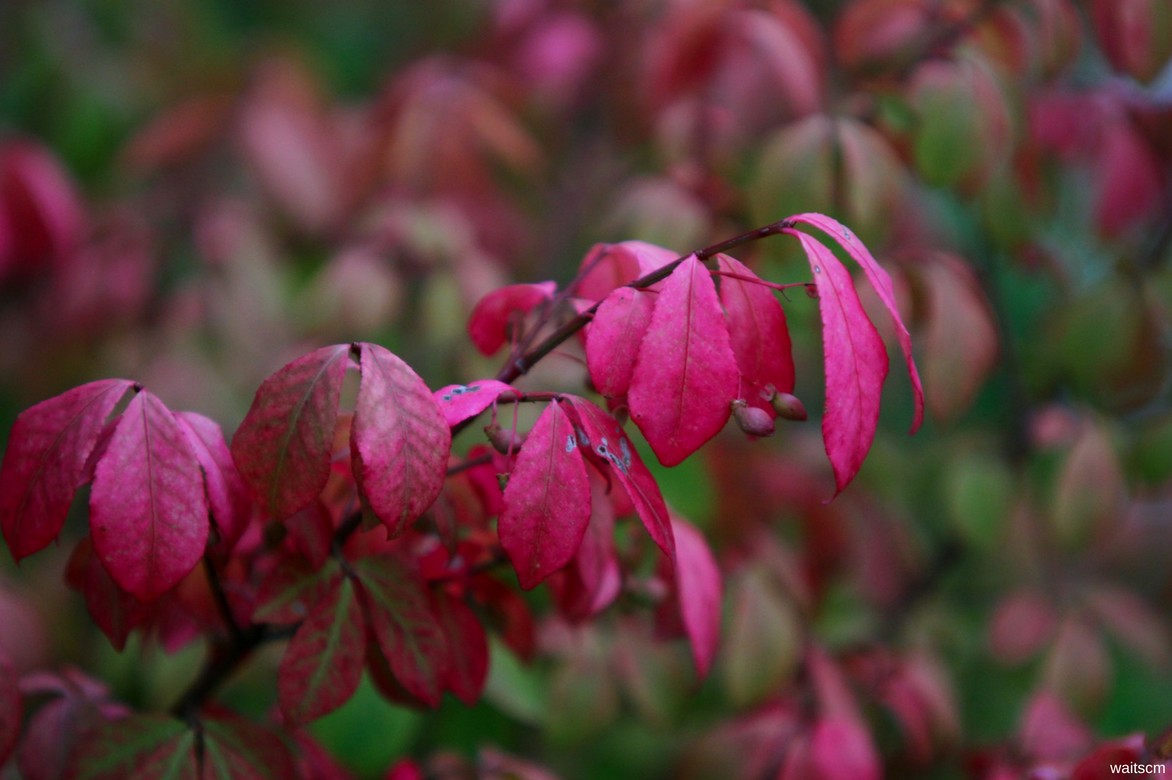
Stunning autumn coloration of Euonymus alatus ‘Compactus’.
When to plant?
Although it is possible to plant spindle trees at any time of the year, it is preferable to do so from October until March or April. Avoid planting during frost or extreme heat.
How to plant?
Allow sufficient space around -1 m² for ground cover species – to enable them to spread harmoniously. In a border or hedge, space the spindle plants 1.50 to 2 m apart from each other and from other trees or bushes, as their dense foliage and significant growth could smother them. Dig a trench rather than individual holes to create a hedge.
Spreading climbing species like Euonymus fortunei ‘Minimus’ (15-20 cm high) should be planted 50-80 cm apart to quickly cover the ground with their fine foliage.
To plant:
- Moisten the root ball to facilitate recovery.
- Dig a planting hole two to three times the size of the root ball. Add a spadeful of well-decomposed compost.
- Place the plant in the planting hole.
- Replace the soil and lightly firm it down.
- Water.
- Spread a layer of mulch around the base to maintain good moisture around the roots. This will also limit the growth of weeds.
For pot cultivation, place a 3-4 cm drainage layer at the bottom of the pot (gravel, broken pottery, etc.). Add a mix consisting of 1/3 soil, 1/3 potting compost, and 1/3 coarse sand.
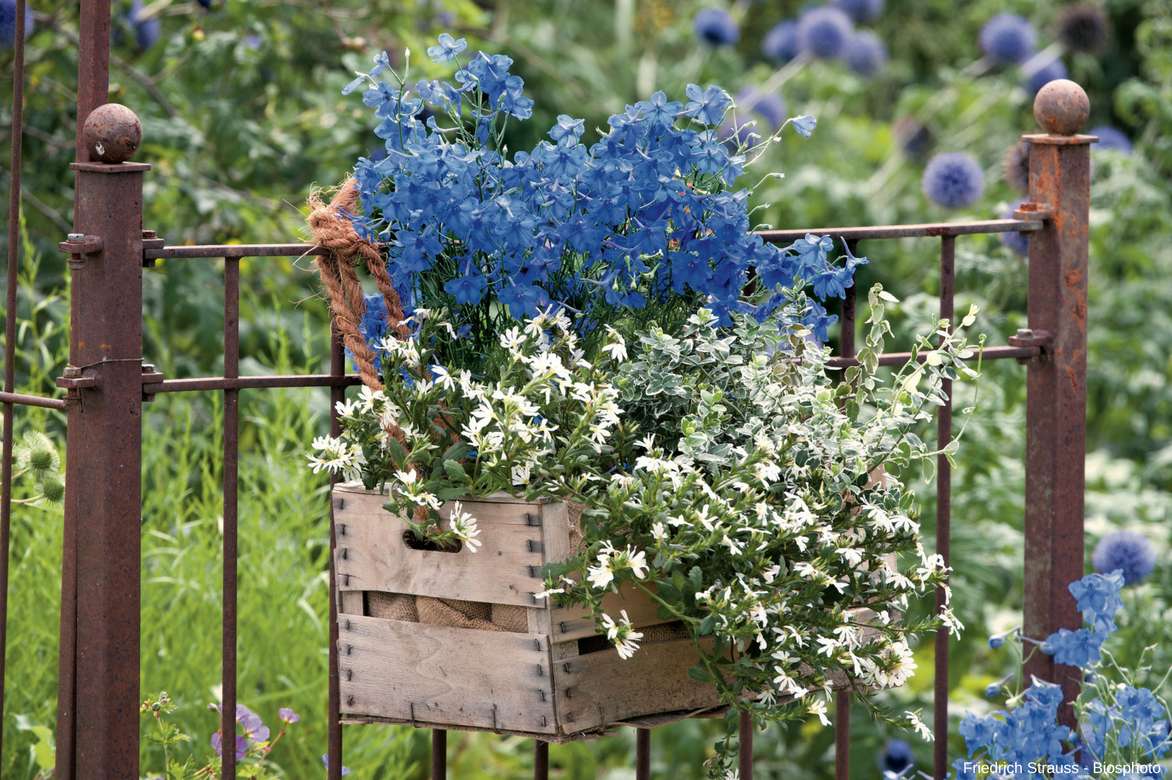
Small evergreen spindle trees are well-suited for above-ground cultivation, here: Euonymus fortunei ‘Emerald Gaiety’, Delphinium ‘Blue Diamonds’, Scaevola ‘White Blessing’.
Pruning and care
Pruning Euonymus
Prune deciduous euonymus in winter to better assess the silhouette using pruning shears. Remove poorly placed branches that cross or are damaged. For euonymus trained on a trunk, eliminate the low branches coming from the trunk.
Euonymus used for edging or topiary should be pruned with shears or bonsai scissors in April and autumn, or even at the time of planting. This will be more of a pinching than a pruning: shorten the leafy stems by a few centimetres without going down to the naked wood. Hedge plants can be pruned with shears or hedge trimmers twice a year, in April and August.
Care
Euonymus are easy to grow trees or bushes that require very little maintenance. Once established, they do not need watering, but it is still preferable to water regularly during the first year and subsequently during dry periods. Similarly, if you are growing your euonymus in a pot or container, water 1 to 2 times a week, as the substrate dries out faster than in open ground.
Installing a mulch at the base will help limit the growth of weeds and protect the bush against drought and frost.
Japanese euonymus are the most sensitive to cold. If you are growing these varieties, protect them during the first few years with a winter cover and by placing a thick layer of mulch on the ground. In case of snow, shake the branches of the evergreen Japanese euonymus to remove it and prevent the branches from breaking under the weight.
Diseases and potential pests
Persistent spindle trees are sometimes attacked by mealybugs that form cottony clusters or small dark shields on the stems or under the leaves. Treat with white oil or introduce natural predators like the ladybird Cryptolaemus montrouzieri.
Powdery mildew leaves a white dusting on the shoots and leaves of the Japanese spindle, particularly when the first hot weather arrives. Quickly cut away the affected parts to prevent spreading. Optionally, apply sulphur to the foliage if symptoms reappear. If your bush is recurrently affected, we recommend moving it to a sunnier and more ventilated area.
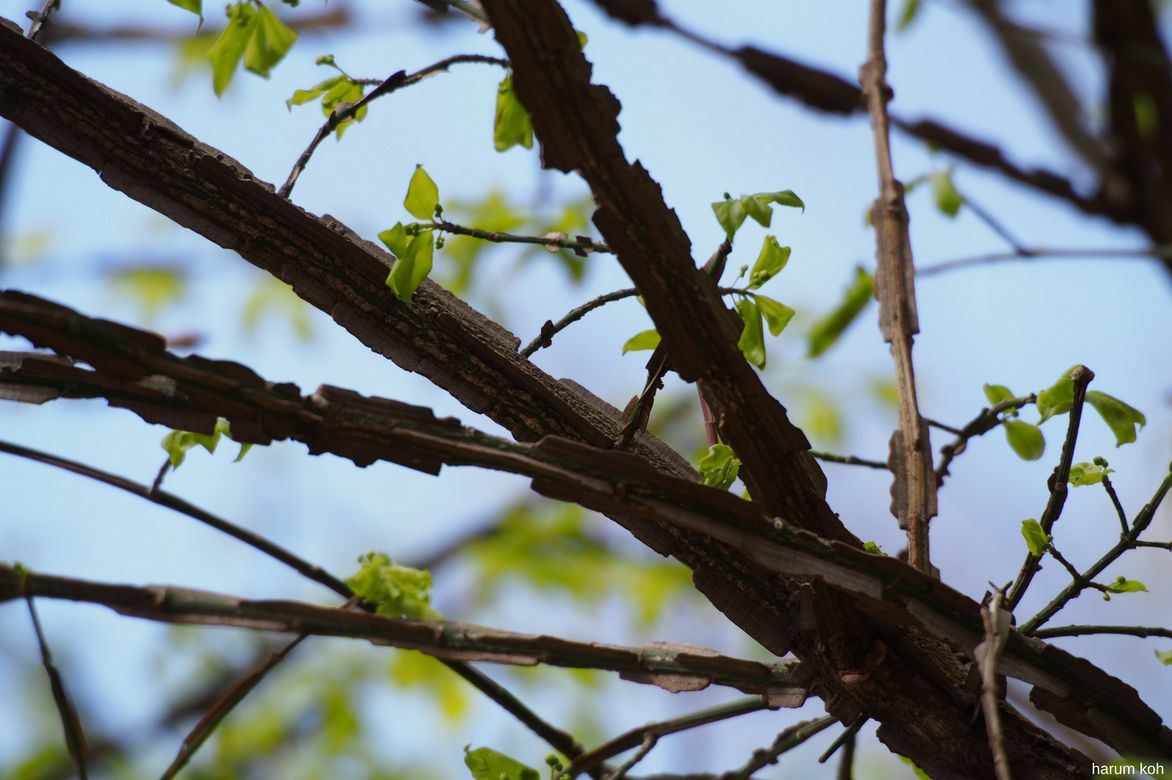
The branches of the winged spindle are very graphic, especially in the heart of winter.
Propagating Euonymus: propagation by cuttings and sowing
Euonymus can be propagated by sowing or by propagation by cuttings. Propagation by cuttings is the best technique for evergreen varieties, while sowing is suitable for deciduous ones. It is also possible to divide the clumps of suckering euonymus.
Propagating an euonymus by cuttings
Evergreen euonymus can be propagated by cuttings in August using semi-ripe shoots, while for deciduous euonymus, you should wait until September to November with ripe shoots.
- Prepare a pot by filling it with potting mix mixed with sand, or take your cuttings directly in the ground if it is light, after aerating it with a fork, then moisten the substrate.
- Take a shoot about ten centimetres long from a current year’s growth, ensuring to pull it out at a branching point to obtain a “heel” (the end of the bearing shoot). It should be healthy and free from diseases.
- Remove the leaves near the base of the cutting, and trim the others to reduce the leaf surface area. Leave only a few leaves at the top if they have not fallen off.
- Dip the base of the stem in plant hormone.
- Make a hole in the substrate using a pencil or a wooden stick.
- Place the cutting in the hole and gently firm the soil around it to eliminate air pockets and ensure good contact between the potting mix and the cutting.
- Cover the pot with a plastic bag to maintain a humid atmosphere, especially if leaves are present. Ventilate occasionally to prevent the development of fungal diseases.
- Place the pot under a frame in a warm, bright location but out of direct sunlight.
- Transplant rooted cuttings in spring into a richer medium and grow them for at least until the following spring before placing the young plants in their final location.
Sowing euonymus
Sowing of deciduous euonymus often occurs spontaneously, but you cannot be sure of obtaining the selected variety initially. Preferably use fresh seeds and consider cold stratification (cold treatment in sand) if sowing in spring to break dormancy.
- Harvest the seeds in autumn when the capsules open and remove the brightly coloured aril (fleshy part).
- To stratify the seeds, place them in a tray filled equally with potting mix and sand, or just sand. Moisten the substrate and mix in the seeds. Seal everything in a plastic bag, then place it in a cold environment (between 0 and 5 °C), such as in the refrigerator, for two to three months. Sometimes, seeds may germinate directly while still cold. In this case, take them out as they germinate and transplant them into pots.
- Remove the seeds from the refrigerator.
- Prepare a pot by filling it with special seed compost.
- Sow the seeds by burying them under 1 cm of soil and place them under a cold frame.
- Water with fine droplets.
Continue to water regularly, but without excess, to keep the substrate moist. Transplant the young seedlings a few months after germination. After one or two years, you can plant them in their final location.
Associating Euonymus in the garden
Spindle trees can create very different scenes depending on the species, as we have seen that the dimensions, habit, and foliage colouration are highly variable. Evergreen dwarf or medium-sized species, whether pruned or not, are used in rock gardens and cottage gardens to replace boxwood, in particular, and to create topiary art.
Place deciduous spindle trees like Evonymus europaeus ‘Red Cascade’ at the back of a bed of asters and Japanese anemones to embrace the scene in autumn or within a free-standing hedge.
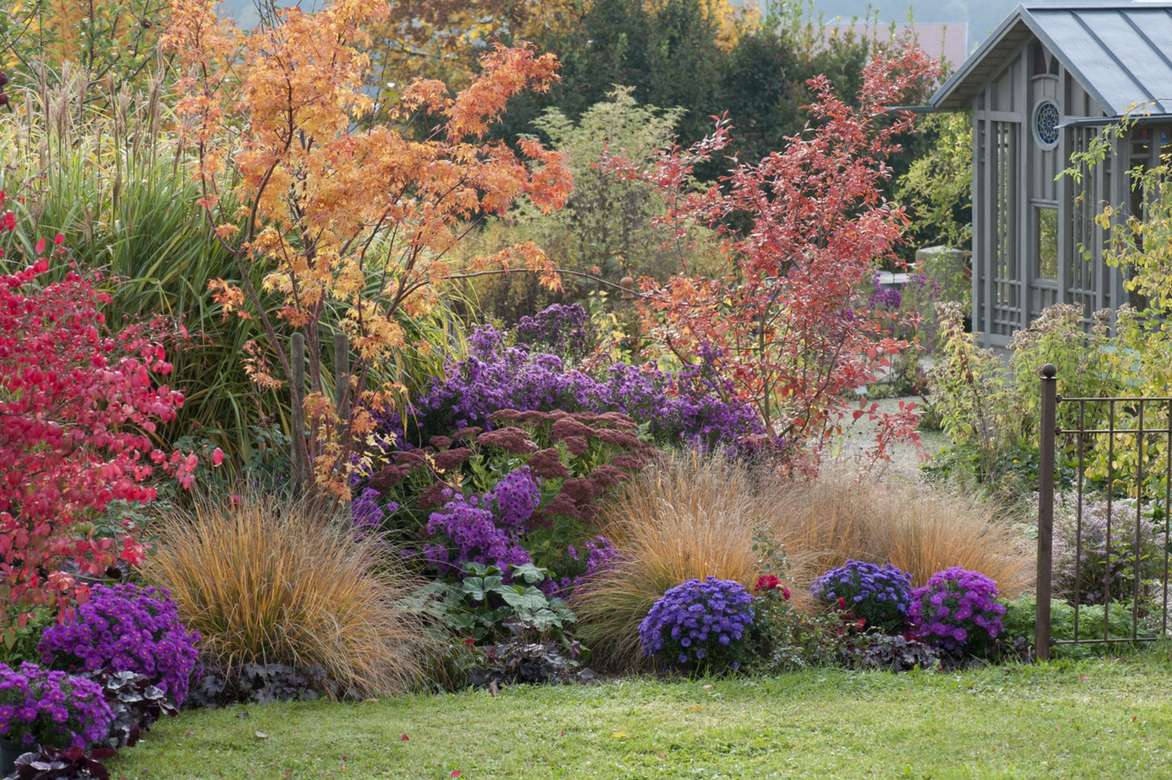
An example of an autumn association: Euonymus alatus, Acer palmatum, Pennisetum alopecuroides ‘Hameln’, Miscanthus sinensis ‘Malepartus’, Sedum ‘Autumn Joy’, Heucheras and various Asters. (Friedrich Strauss – Biosphoto)
Japanese spindle tree is an ideal partner for creating windbreak hedges by the sea, as it does not like confined spaces or harsh winters.
Creeping spindle tree like fortunei ‘Emerald Gaiety’ has a rapid growth that allows it to carpet the ground of a bed while brightening it with its olive green and cream tones, turning pink during winter. It creates a lovely colourful scene alongside bronze fennel or dwarf roses. It is also original to guide the stems up the trunk of a large tree leaning at about 3 m high or to use it in hanging arrangements, paired with bright pink cyclamen.

An example of an association: Euonymus fortunei ‘Emerald Gaiety’, Nicotiana alata, Lythrum salicaria, Stachys byzantina, Hydrangea quercifolia ‘Snow Queen’.
To go further
- Discover our wide range of spindle trees: the most beautiful varieties, deciduous or evergreen
- Find our tips to identify, prevent, and combat the diseases and parasitic issues of Japanese spindle
- Discover our advice on growing an evergreen spindle in a pot
- Our advice sheet: which spindles for a hedge?
- Our advice sheet: which spindles for a colourful winter?
- Our advice sheet: the best ground-cover spindles
- Our advice sheets: Japanese spindle, the most beautiful varieties and 5 essential evergreen spindles
- Our advice sheets: The most beautiful colourful spindles in autumn; 7 spindles with exceptional variegated foliage
- Also discover how to train a spindle tree?
- Learn more about Euonymus planipes or Euonymus sacchalinensis in Olivier’s video!
- Discover 7 spindles with decorative fruits
Frequently asked questions
-
The leaves of my spindle are being devoured by caterpillars in spring. How can I get rid of them?
This is the caterpillar of the spindle moth, a white butterfly with black spots, measuring 2 cm, which lays its eggs on the bark at the end of summer-autumn. The white caterpillars with black spots that overwinter in a sort of brownish shield attack the leaves as soon as the bud burst period begins, producing significant webs and silky nests in the foliage of the European spindle, which they are particularly fond of. You can cut the infested branches and foliage and burn them to limit the infestation, then apply a preparation based on Bacillus thuringiensis that targets the caterpillars. You can also apply an insecticidal oil to the naked branches during winter to eliminate the eggs and larvae.
- Subscribe!
- Contents
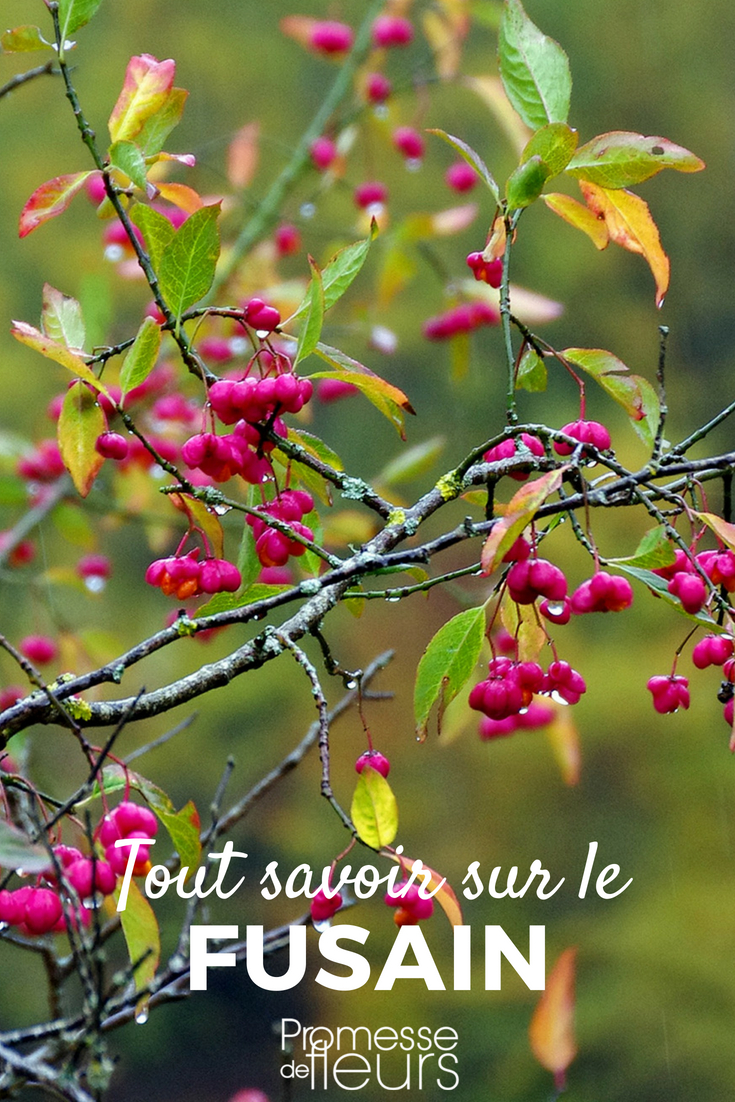

































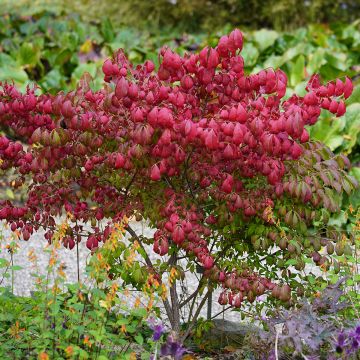


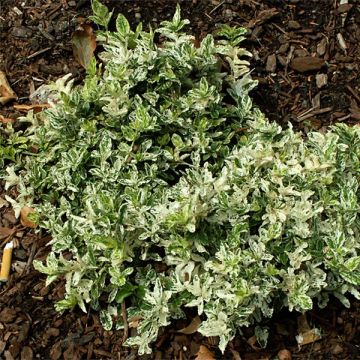
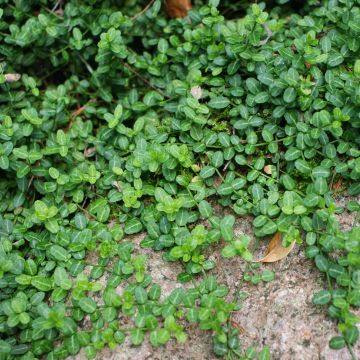



Comments